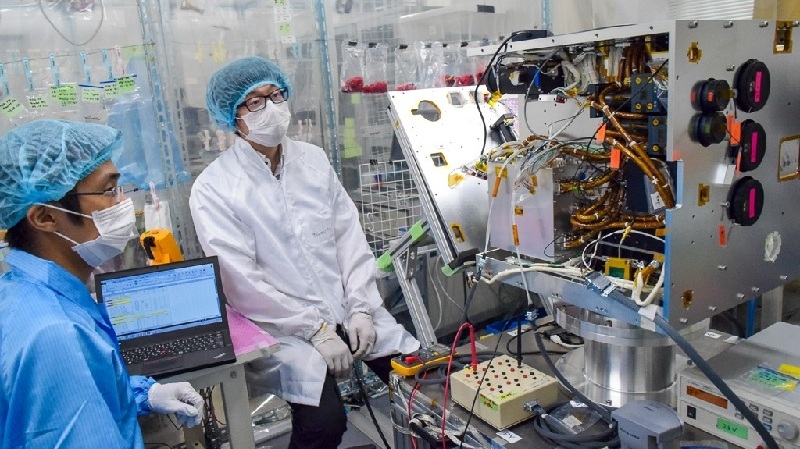
MicroDragon is being tested by VNSC engineers. (Photo: VNSC)
Their first product, MicroDragon, has been launched into space, bringing with it the intellect and space conquest aspiration of young Vietnamese people.
Following the launch of MicroDragon in January 2019, Vietnam plans to launch the NanoDragon satellite in 2020. The 50-kilogram MicroDragon was sent into orbit aboard a Japanese rocket and is tasked with observing, taking photos and monitoring the quality of coastal water to serve the fishery industry. The satellite is also designed to detect cloud coverage to help with atmospheric correction, and receive and transmit signals between two distant locations on earth. With MicroDragon, Vietnam can improve its capacity in natural disaster prevention and climate change mitigation.
In the meantime, the under-10-kilogram NanoDragon is being developed by the VNSC’s engineers and experts in Vietnam. The satellite will be given the task of testing the technology to control the direction of satellites in orbit and receive automatic vessel identification signals. The design, manufacture, launch and operation of NanoDragon is part of the national space technology programme during the 2016-2020 period.
The VNSC already had experience in designing the 1-kilogram PicoDragon in 2013 but the manufacture of a larger satellite such as the 50-kilogram MicroDragon was nevertheless a long step. In order to fulfil this important mission, during the entire project duration from 2013 to 2017, students and instructors met roughly every three months to evaluate their designs at alternating universities. The evaluation method and content strictly follow the European Space Agency’s satellite development system procedures.
The students were able to participate directly in the process from research and design to the manufacture, assembly and testing of MicroDragon. “The entire manufacturing process took place in Japan with training as the main purpose. So it is safe to say that this is a satellite manufactured by Vietnamese people,” said VNSC Deputy Director Vu Viet Phuong.
MicroDragon is equipped with a multispectral imager camera that can function across 12 different spectral ranges. However, its resolution is only approximately 70 metres, meaning only objects larger than 70 metres can be distinguished, appropriate for observing ocean colours for research and the evaluation of plankton in the ocean.
Phuong said “The greatest meaning of successfully manufacturing MicroDragon lies in the purpose of training, that is mastering satellite technology and our young engineers have made it. MicroDragon passed all ground tests and has been approved by the Japan Aerospace Exploration Agency for launch in mid-January.”
After introducing the Japanese-funded MicroDragon project, Dr Le Xuan Huy from the VNSC shared about the difficulties facing the young Vietnamese engineers during the time they took part in the satellite research, design and manufacture in Japan.
“MicroDragon consists of many components, structures and stages, and they are very complex. The research and development tasks were assigned to each group of engineers studying at five universities based on the professional competency of each group at these institutions. Because the working conditions and methods are different between these universities, and they are scattered across Japan, the engineers encountered quite a lot of difficulties when integrating and testing the entire system,” said Dr Huy.
The optical sensor of the satellite is an extremely important part, considered as the “eye” of the satellite. The interesting thing is that the “eye” was designed by the first female engineer of the VNSC, Nguyen Thi Thao, who was born in 1989. Sharing the enthusiasm and passion for space science like Thao, the other young Vietnamese scientists who were sent to Japan all made great efforts to overcome numerous difficulties and fulfil the mission successfully.
The time when 36 young engineers of the VNSC concluded their education programme in Japan was also when MicroDragon - a product of Vietnamese intellect and spirit - was completed and stored in Japan, ready for launch.
Thao and the other young scientists of the VNSC have returned to Vietnam and continue to work hard in laboratories to pursue their passion of space research with a vow to “devoting their youth to the Vietnamese people’s dream of space exploration.”
The launch of MicroDragon, manufactured by Vietnam under Japanese guidance and assistance, is a step in realising the Vietnamese dream of mastering satellite technology and conquering space./.
NDO
 Da Nang invests over 200 billion VND in semiconductor chip design, AI development
Da Nang invests over 200 billion VND in semiconductor chip design, AI development



